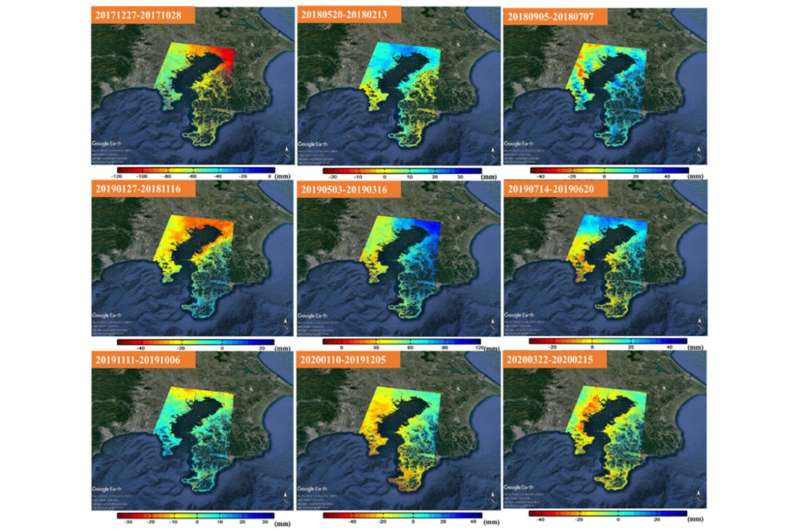This article has been reviewed according to Science X's editorial process and policies. Editors have highlighted the following attributes while ensuring the content's credibility:
fact-checked
proofread
Investigating land subsidence in Japan through consecutive DInSAR and the law of material conservation

Land subsidence is a phenomenon wherein the Earth's surface sinks downwards. It occurs mainly due to human activities, such as excessive groundwater extraction. It is a major global concern, affecting 19% of the world's population. In Japan, some parts of the Tokyo metropolitan region are already sinking. This process can accelerate the flooding of coastal areas and cause damage to buildings and infrastructure. Therefore, monitoring land subsidence is crucial.
In Japan, observation wells are utilized to measure changes in the land surface and groundwater levels every few months. Additionally, the global navigation satellite system (GNSS) is also popular. However, observation wells are more reliable because atmospheric effects can modify GNSS observations. Observation wells require regular maintenance of their machines, which is expensive.
Further, there is an anticipated shortage of engineers qualified to undertake the job as the Japanese population gets older with a declining birth rate. In this light, a new land subsidence monitoring technique—interferometric synthetic aperture radar (InSAR)—is gaining attention.
Recently, Katsunoshin Nishi, a Ph.D. student at the Graduate School of Science and Engineering at Chiba University, Japan, along with a group of researchers, applied consecutive differential InSAR (DInSAR) to investigate land subsidence in Yokohama, Yokosuka, and Miura cities of Kanagawa prefecture in Japan. They compared the results obtained with those of other monitoring techniques. Their work was published in Geocarto International.
"InSAR is a remote sensing technique that uses two satellite SAR images to measure surface elevation. It exploits the phase of the satellite signal waves for the purpose. Going a step further, Consecutive DInSAR can measure millimeter changes in the elevation in time series, thus detecting land subsidence. It is quantified in terms of subsidence rate or land surface velocity," explains Mr. Nishi.
The work also involved contributions from Masaaki Kawai from Mitsubishi Heavy Industries Ltd, Japan, Bowo Eko Cahyono from the University of Jember, Indonesia, Mirza Muhammad Waqard from Lumir Inc, Korea, Kaori Nishi from Bella Earther, Japan and Josaphat Tetuko Sri Sumantyo Chiba University, Japan and Universitas Sebelas Maret, Indonesia.
In their study, the researchers analyzed the images acquired by Sentinel 1 European Space Agency satellite program—from August 2017 to March 2022 using SARPROZ software, which implements DInSAR. In addition, they also formulated a new computation model called "the law of material conservation." It uses surface pressure values to calculate groundwater level and the amount and cause of land subsidence.
The researchers found that Consecutive DInSAR results were consistent with both observation well and GNSS data. Its mean subsidence rate of 1.58 cm/year was respectively within 0.02 cm/year and 0.90 cm/year of their corresponding values. Also, its mean Root Mean Square Error (RMSE) was respectively 0.39 cm/year and 0.46 cm/year of their corresponding values. Further, the land subsidence mechanisms could be accurately identified through the proposed law.
In conclusion, Mr. Nishi highlights the long-term potential of the new monitoring technique. "By utilizing Consecutive DInSAR and satellite data, the government can take effective and timely measures to tackle land subsidence. Further, determining the extent and cause of land subsidence will enable the administration to set land subsidence thresholds and limit groundwater use. Consequently, people in coastal regions or previously-land subsided areas can live safely and securely."
Overall, Consecutive DInSAR can potentially substitute the land subsidence observation well technique in future.
More information: Katsunoshin Nishi et al, Consecutive DInSAR and well based on the law of material conservation between land surface pressure and ground water to observe land subsidence, Geocarto International (2022). DOI: 10.1080/10106049.2022.2159069
Provided by Chiba University





















